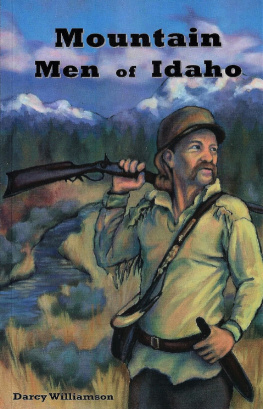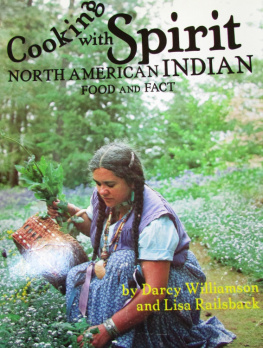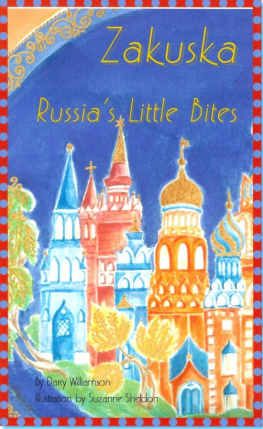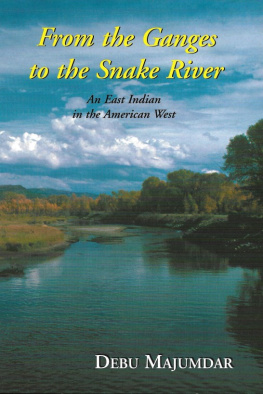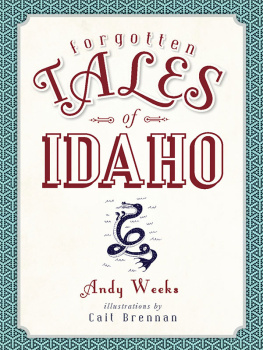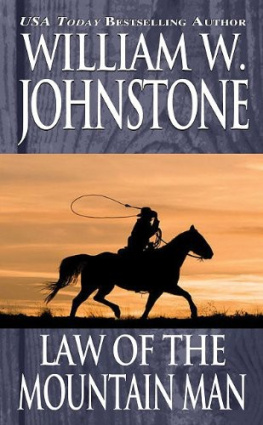Darcy Williamson - Mountain Men of Idaho
Here you can read online Darcy Williamson - Mountain Men of Idaho full text of the book (entire story) in english for free. Download pdf and epub, get meaning, cover and reviews about this ebook. year: 2010, publisher: Darcy Williamson, genre: Detective and thriller. Description of the work, (preface) as well as reviews are available. Best literature library LitArk.com created for fans of good reading and offers a wide selection of genres:
Romance novel
Science fiction
Adventure
Detective
Science
History
Home and family
Prose
Art
Politics
Computer
Non-fiction
Religion
Business
Children
Humor
Choose a favorite category and find really read worthwhile books. Enjoy immersion in the world of imagination, feel the emotions of the characters or learn something new for yourself, make an fascinating discovery.
- Book:Mountain Men of Idaho
- Author:
- Publisher:Darcy Williamson
- Genre:
- Year:2010
- Rating:3 / 5
- Favourites:Add to favourites
- Your mark:
- 60
- 1
- 2
- 3
- 4
- 5
Mountain Men of Idaho: summary, description and annotation
We offer to read an annotation, description, summary or preface (depends on what the author of the book "Mountain Men of Idaho" wrote himself). If you haven't found the necessary information about the book — write in the comments, we will try to find it.
74 Short Stories of Idaho's Mountain Men
They were hunters, trappers, bear fighters, Indian killers who lived off the land and survived annual rendezvous. The sun, the wind, the harsh winter climate tanned and dried and leathered their faces until those without beards (and there were a few) had to roll up their sleeves to bare white arms as proof of their Caucasian identity.
Mountain Men of Idaho — read online for free the complete book (whole text) full work
Below is the text of the book, divided by pages. System saving the place of the last page read, allows you to conveniently read the book "Mountain Men of Idaho" online for free, without having to search again every time where you left off. Put a bookmark, and you can go to the page where you finished reading at any time.
Font size:
Interval:
Bookmark:
Mountain Men ofIdaho
by
Darcy J. Williamson
PUBLISHED BY:
Darcy Williamson onSmashwords
Mountain Men of Idaho
Copyright 2010 by DarcyWilliamson
All rights reserved. Without limitingthe rights under copyright reserved above, no part of thispublication may be reproduced, stored in or introduced into aretrieval system, or transmitted, in any form, or by any means(electronic, mechanical, photocopying, recording, or otherwise)without the prior written permission of both the copyright ownerand the above publisher of this book.
Smashwords Edition LicenseNotes
This ebook is licensed for yourpersonal enjoyment only. This ebook may not be re-sold or givenaway to other people. If you would like to share this book withanother person, please purchase an additional copy for each personyou share it with. If you're reading this book and did not purchaseit, or it was not purchased for your use only, then you shouldreturn to Smashwords.com and purchase your own copy. Thank you forrespecting the author's work.
ISBN 9780984313617
Contents
ARTISANS ~ Members of larger tradingposts who worked as blacksmiths, carpenters and boatbuilders.
BOURGEOIS ~ The person in charge of atrading post and its field expeditions.
BULL-BOAT ~ A boat made of a largeanimal skin (preferably buffalo), stretched over a frame of willowor cottonwood poles.
CACHE ~ Property or goods of trapperstemporarily hidden in a carefully concealed pit.
CAMP KEEPER ~ The person who skinnedbeaver, cleaned, dressed and dried the pelts, took care of thestock and attended to other duties of the trappers camp. There wasusually one camp keeper for every two trappers.
CLERK ~ The first in line for promotionto the rank of bourgeois, and in the latters absence, preformedhis duties.
DUGOUT ~ A wooden canoe dug out fromthe trunk of a tree (usually cottonwood.)
FREE TRAPPER ~ A trapper not bound bycontract or agreement with any fur-trading company.
MANGEURS DE LARD ~ ImportedCanadians who were used as raw recruits in the fur trade. Fedprincipally on pork, they were called mangeurs de lard . This term came tobe used in ridicule to denote greenhorns.
PACKS ~ Bundles of furs securelywrapped for transport to market. Each pack usually contained eightybeaver pelts and weighed around 100 lbs.
PEMMICAN ~ Buffalo meat which wassliced paper thin and dried, then pounded to a fine powder andmixed with melted buffalo cow fat. Often dried serviceberries wereadded. The mixture was packed into hide sacks and used as a staplewhen fresh meat was unavailable. Pemmican would retain its ediblequality for a number of years.
RENDEZVOUS ~ An annual meeting oftrappers and Indians for the purpose of trafficking furs andpurchasing equipment for the ensuing year.
VOYAGEURS ~ French Creoles hired tonavigate canoes or other crafts along streams and rivers. They wereusually devout Catholics and almost always illiterate.
Andrew Henry was born in Pennsylvaniaaround 1775. Having been born to a life of affluence and socialprominence, he prospered and thrived. He had developed into a tallman with a swarthy dark complexion and a taste for the finer thingsin life. Andrew wore the latest fashions, dined in the finest homesand wooed the ladies by playing quixotic melodies on his violin. Healso kept himself active in various organizations, often holdinghigh positions within their structure; and being civic-minded,served as election judge and juryman. Then, at the age ofthirty-three, he apparently tired of the easy life.
In 1809, Andrew Henry joined ManuelLisa, Jean Pierre Chouteau and seven others in organizing theMissouri Fur Company. Not content to operate behind the scenes froman office in St. Louis, Henry donned buckskins and headed to theRocky Mountains. In the Rockies he contended with the hardships ofthe trade; grizzly bear attacks; fighting Blackfoot warriors;hunger; cold; thirst; exhaustion.
Many of the trappers working for theMissouri Fur Company were from various Indian tribes. The MissouriFur Company had relied on Indians to do the actual trapping andhunting that produced the furs. The furs were then brought totrading posts where, with increasing frequency, the Indian trapperswere given liquor as an actual medium of exchange. The pattern wasso firmly established that it was difficult to conduct businesswithout a substantial supply of alcohol. In July of 1822, a law wasenacted prohibiting the sale or trade of alcohol toIndians.
Andrew Henry then joined with WilliamH. Ashley to form a new business, The Rocky Mountain Fur Company,based in Saint Louis, Missouri. Advertisements were posted in St.Louis newspapers seeking "One Hundred enterprising young men...to ascend the river Missouri to its source, there to be employedfor one, two, or three years." Among those hired were JedediahSmith, William Sublette, Milton Sublette, Jim Beckworth, ThomasFitzpatrick and David Edward Jackson.
Andrew Henry retired from the fur tradetwo years later in 1824, at the age of fifty, and died in1832.
Andrew Henry could have lived and dieda very wealthy man. He didnt. He had chosen adventure instead. Heonce told a friend that he had suffered a great deal and had metwith many misfortunes. But he left a legacy which must certainlyhave eased some of his losses ~ the establishment of Fort Henry, inpresent-day Idaho, the first American fur post erected on thePacific side of the Rockies.
During the spring of 1810, Andrew Henryand his men built a fort on the Three Forks of the Missouri.However, a little over a month later the fort came under attack.Eight trappers lost their lives fighting the territorial Blackfeet.Many other men were seriously wounded.
Knowing that the attacks wouldcontinue, Henry abandoned the fort. He and his company ascended theMadison River, crossed the Continental Divide and came upon a lake(later named Henrys Lake). The group continued on until they founda well-watered district with numerous tributaries. Here AndrewHenry erected a fort (in the vicinity of the present city of St.Anthony). Three log cabins were built to serve as temporary winterquarters for his men.
The area had at first seemed ideal forsuch a post. There was an abundance of game, wood and grass.Streams crisscrossed the area and beaver ponds werecommon.
The Shoshoni called the area Egin,meaning cold. Its elevation was 4,600 feet and was an area proneto heavy snowfall. Below-zero temperatures often persisted forweeks during the winter months. Had Andrew Henry known this, thefort would most likely have been moved seventy miles farther southto the bottomlands of the Portneuf.
The winter of 1810 was harsh. The gameleft the area and the men had difficulty obtaining food. Theysubsisted on the flesh of their horses. Though the men suffered agreat deal from the cold, no deaths were recorded.
The spring hunt of 1811 brought inforty packs of beaver pelts from the area. However, at theconclusion of the spring trapping season, Henry abandoned thefort.
While trapping in the Rockies with aparty of William Ashleys men, commanded by Major Henry, Hugh Glasswas severely mauled by a large female grizzly bear. His companionsfound Glass barely alive; his breathing was coming in torturedrasps; blood flowed freely from numerous gashes and the dying manlay in a bath of his own coagulating blood.
His trapping comrades held vigilancethroughout the first night. Then the next. And the next. Theunconscious Glass was taking his time dying and the mountain mencouldnt wait around forever. John Fitzgerald and Jim Bridgervolunteered to stay with the dying man. Several days later theycontemplated putting the suffering man out of his misery, butneither could come up with the nerve. Glass seemed to slip furtherand further towards death.
A week later, Fitzgerald and Bridgerrejoined their brigade at Fort Henry with the news that Glass wasdead. They had with them his gun and knife.
Next pageFont size:
Interval:
Bookmark:
Similar books «Mountain Men of Idaho»
Look at similar books to Mountain Men of Idaho. We have selected literature similar in name and meaning in the hope of providing readers with more options to find new, interesting, not yet read works.
Discussion, reviews of the book Mountain Men of Idaho and just readers' own opinions. Leave your comments, write what you think about the work, its meaning or the main characters. Specify what exactly you liked and what you didn't like, and why you think so.

